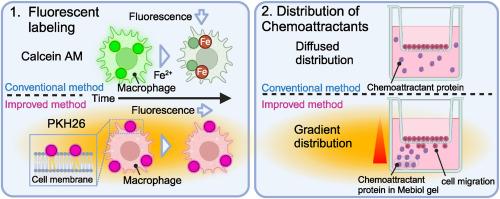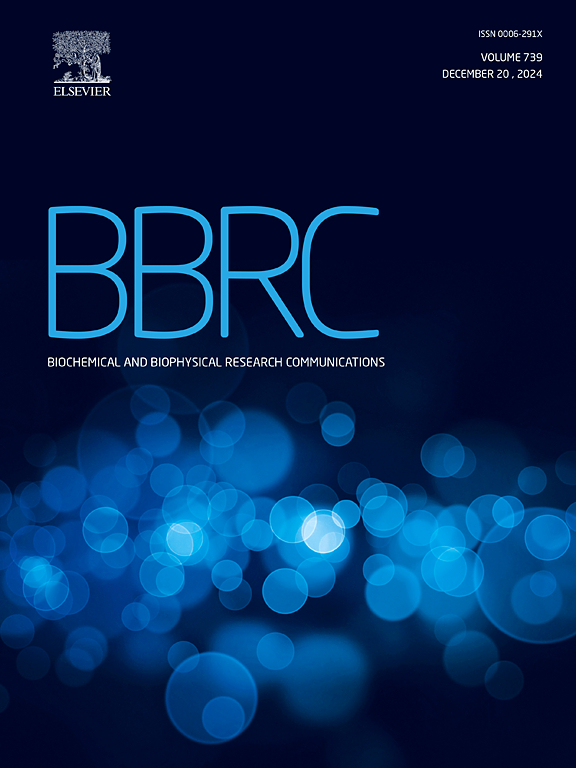优化细胞迁移试验:荧光标记和趋化梯度的关键作用
IF 2.5
3区 生物学
Q3 BIOCHEMISTRY & MOLECULAR BIOLOGY
Biochemical and biophysical research communications
Pub Date : 2024-11-14
DOI:10.1016/j.bbrc.2024.150998
引用次数: 0
摘要
细胞迁移试验又称趋化试验,广泛用于测量癌细胞、白细胞、巨噬细胞和其他运动细胞类型的迁移能力。在这些试验中,将荧光标记的细胞播种到带有微孔膜的细胞培养插片上,微孔膜可阻挡 490 纳米到 700 纳米的光透射。然后使用荧光显微镜从微孔膜底部观察迁移细胞并进行量化。在这项研究中,我们使用巨噬细胞作为运动细胞进行了细胞迁移试验。我们发现,使用钙黄绿素乙酰氧甲基酯(钙黄绿素 AM)进行荧光标记的常用方法会导致某些类型的细胞在迁移实验中荧光信号随时间衰减,从而可能影响实验的稳定性。本研究利用 PKH26 克服了这一局限性,PKH26 通过不同于钙黄绿素 AM 的机制对细胞表面进行荧光标记。通过这种改良,我们观察到迁移巨噬细胞的数量随着时间的推移持续增加。我们还证明,趋化诱导剂梯度是细胞迁移实验成功的关键。我们改进的方案为细胞迁移实验提供了可靠而稳定的结果。本文章由计算机程序翻译,如有差异,请以英文原文为准。

Optimizing cell migration assays: Critical roles of fluorescent labeling and chemoattractant gradients
Cell migration assays, also known as chemotaxis assays, are widely used to measure the migratory capacities of cancer cells, leukocytes, macrophages, and other motile cell types. In these assays, fluorescently labeled cells are seeded onto cell culture inserts with microporous membranes that block light transmission from 490 to 700 nm. The migrated cells are then observed and quantified from the bottom of the microporous membrane using a fluorescence microscope. In this study, we conducted cell migration assays using macrophages as the motile cells. We discovered that the commonly employed fluorescent labeling method using calcein acetoxymethyl ester (calcein AM) can lead to the time-dependent attenuation of fluorescent signals in certain cell types during migration assays, potentially compromising assay stability. This study overcame this limitation by utilizing PKH26, which fluorescently labels cell surfaces through a mechanism distinct from that of calcein AM. With this modification, we observed a consistent increase in the number of migrating macrophages over time. We also demonstrated that the gradient of chemoattractants is key to the success of cell migration assays. Our improved protocol provided reliable and stable results for cell migration assays.
求助全文
通过发布文献求助,成功后即可免费获取论文全文。
去求助
来源期刊
CiteScore
6.10
自引率
0.00%
发文量
1400
审稿时长
14 days
期刊介绍:
Biochemical and Biophysical Research Communications is the premier international journal devoted to the very rapid dissemination of timely and significant experimental results in diverse fields of biological research. The development of the "Breakthroughs and Views" section brings the minireview format to the journal, and issues often contain collections of special interest manuscripts. BBRC is published weekly (52 issues/year).Research Areas now include: Biochemistry; biophysics; cell biology; developmental biology; immunology
; molecular biology; neurobiology; plant biology and proteomics

 求助内容:
求助内容: 应助结果提醒方式:
应助结果提醒方式:


